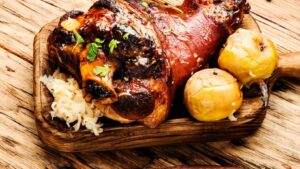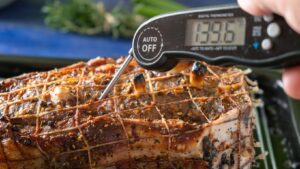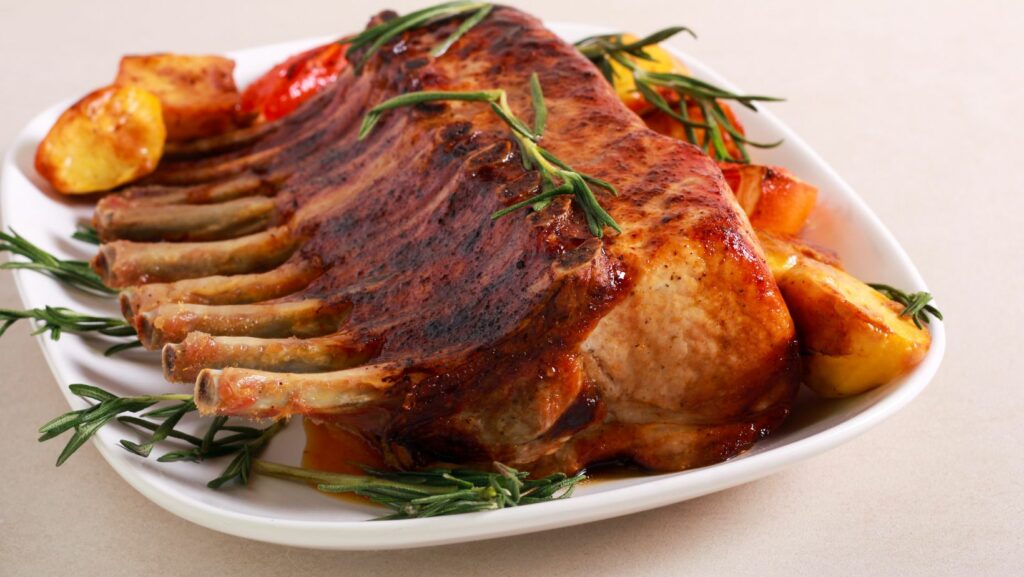Mastering the art of a perfectly cooked bone-in pork roast is no small feat. It’s a dance between time and temperature, a delicate balance that, when struck just right, yields a succulent, flavorful feast fit for any occasion.
Bone-in Pork Roast Cooking Time and Temperature

Navigating cooking time and temperature unravels the path to perfectly cooked bone-in pork roast. Oven temperature dictates the cooking time, indirectly affecting meat texture and flavor. A high temperature offers a faster cook, yet it risks dehydrating the pork. Conversely, a lower temperature extends cooking hours but ensues a tender, juicy roast.
In terms of time, bone-in pork roast typically requires 20 minutes per pound at 350 degrees Fahrenheit. However, the prime indicator for a well-cooked roast remains its internal temperature. It’s essential to achieve a 145-degree internal temperature, followed by a three-minute rest time, as stated by the USDA.
The right temperature ensures safety and tenderness, anchoring the cooking process. It’s like a culinary compass, guiding chefs towards succulent pork roast results, free of guesswork. Remember, relying solely on cooking time can lead astray, underscoring the importance of using a meat thermometer for precision.
A clear grasp of this interplay between time and temperature unlocks the door to mouth-watering, impeccably cooked bone-in pork roast. This interdependence, if mastered, grants culinary ingenuity, presenting a coveted dish that guests won’t easily forget.
Essential Tips for Cooking Bone-In Pork Roast

When crafting a bone-in pork roast, specific nuanced strategies enhance the meat’s mouthwatering appeal.
Utilize a meat thermometer: As the article underscored, don’t dismiss a meat thermometer’s worthiness. It ensures steadfast accuracy, eliminating guesswork. For example, Thermoworks and Lavatools offer highly recommended options. Preheat the oven: Preheating paves the way for an evenly cooked roast, stabilizing its environment.
Avoid over-seasoning: Though tempting, excessive seasoning can overshadow the meat’s inherent flavor. A balanced blend of salt, pepper, and subtle herbs amplifies the roast’s taste. Insert thermometer correctly: Placement of the thermometer in the thickest part of the roast, avoiding fat and bone, grants authentic temperature readings. Respect the resting time: Post cooking, it’s imperative to let the roast rest for a minimum of 3 minutes, as endorsed by USDA. This allows the juices to redistribute, ensuring a moist, tender, and delicious pork roast.
Best Practices for Juicy and Flavorful Pork Roast
Enhancing flavor begins with marination; an overnight process in fridge can ensure flavors seep deep into the meat. Cut slits on the meat’s surface, add salt, garlic, olive oil, or even apple cider vinegar to the marinade, guaranteeing flavor penetration. Preheating the oven to a conservative 350 degrees Fahrenheit helps cook the pork evenly. Prior to roasting, bring the pork to room temperature. A room-temperature roast ensures even cooking, eliminating occurrences of a cold center.

Consistency is key when roasting. Maintaining a steady oven temperature aids this process. Applewood or hickory chips introduced in the roasting process can additionally infuse a smoky flavor into the pork. Further, one must avoid overcooking; a digital thermometer removes guesswork, facilitating precise reading of internal temperature, set to a perfect 145 degrees Fahrenheit. After roasting, it’s crucial to allow the pork to rest for at least three minutes to capture and retain juices within, ensuring a perfectly succulent bone-in pork roast.
Common Mistakes to Avoid
Mastering the bone-in pork roast isn’t as intimidating as it may seem. However, it’s easy to fall into common pitfalls. Overcooking is a frequent mistake, leading to a tough, dry roast. Remember, it’s all about reaching that magic internal temperature of 145 degrees Fahrenheit. Skipping the rest period is another error. That three-minute pause isn’t just a suggestion, it’s a requirement for juicy, succulent pork. Neglecting to preheat the oven can also throw off cooking times and affect the roast’s texture. Lastly, don’t underestimate the power of marination and the smoky flavor of wood chips.

